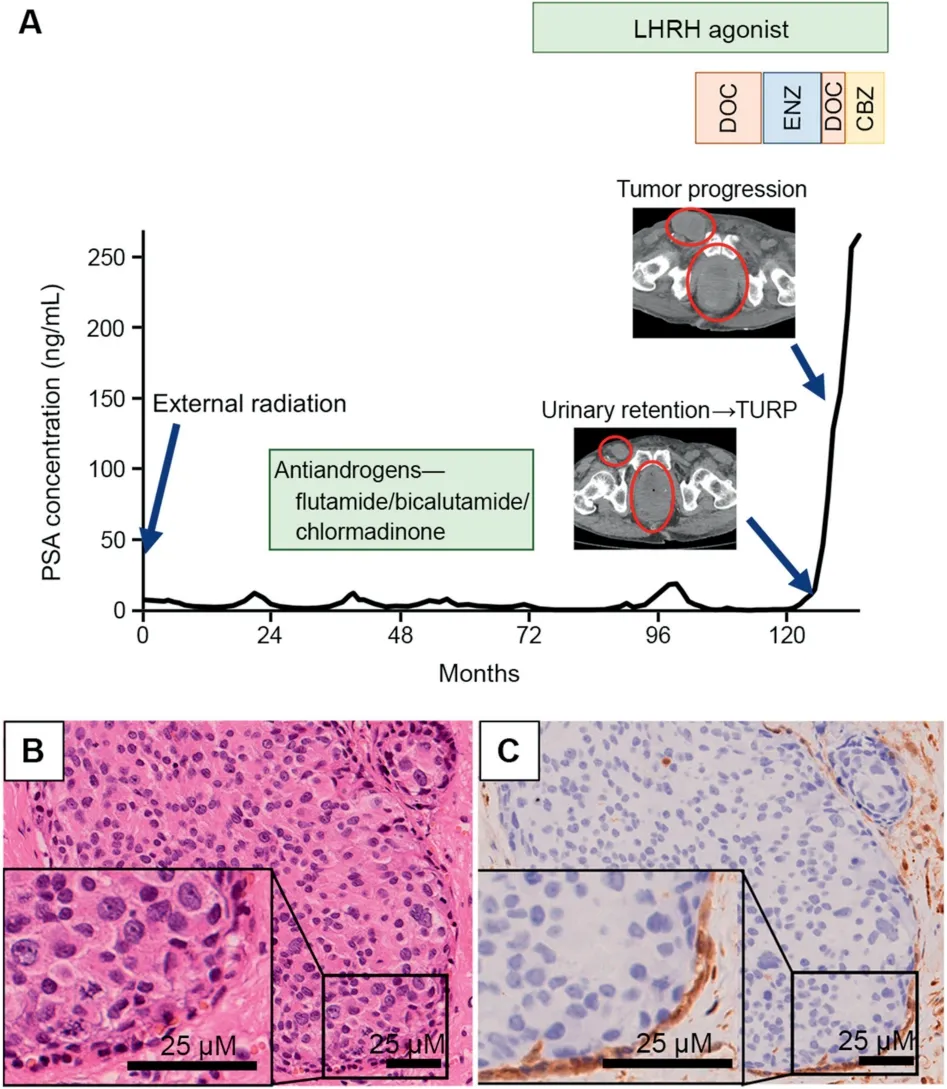The first Japanese case of intraductal cancer of the prostate with checkpoint kinase 2 mutation
Dear editor:
Intraductal carcinoma of the prostate(IDC-P)is characterized by expansive growth of cancer cells in normal prostatic ducts with basal cell layer and associated with high grade invasive prostate cancer (PCa).However,the molecular profile or clinical character of IDC-P in progressive castration-resistant PCa(CRPC)was not fully characterized yet.
A 62-year-old man diagnosed with prostatic adenocarcinoma (Gleason score,4+3=7) and serum prostate-specific antigen (PSA) of 7.81 ng/mL underwent external beam radiation therapy.Although his PSA concentration decreased to 2.61 ng/mL,it started increasing within 1 year.Combined androgen blockade was started and his PSA concentration dropped temporarily.Recurrent cancer developed as CRPC within 1 year.He sequentially received docetaxel therapy and enzalutamide.However,he developed urinary retention;magnetic resonance imaging and computed tomography scans showed a diffusely spread prostate tumor and an internal iliac lymph node metastasis (Fig.1A).We performed prostate biopsy and transurethral resection of the prostate.Pathological examination showed intraductal carcinoma and acinar adenocarcinoma with phosphatase and tensin homolog (PTEN) deficiency (Fig.1B and C).Although cabazitaxel therapy was attempted,the tumor expanded to the rectum and his systemic condition worsened gradually.Palliative care was started and the patient was transferred to another hospital.Written informed consent was obtained from the patient for the publication of this case report.This study was approved by the Ethics Committee of Keio University Hospital (Approval number 20150285,20160084).
We performed next-generation sequencing using a custom panel using DNA from formalin-fixed paraffinembedded tissue of the transurethral resection of the prostate specimen (SupplementaryMethodsand Supplementary Table 1).We identified six genetic variants in the tissue sample includingPTENp.R233*,checkpoint kinase 2 (CHEK2) p.V498F,mammalian target of rapamycin(MTOR) p.R32W,SWI/SNFrelated,matrix associated,actin dependent regulator of chromatin,subfamily A,member 4(SMARCA4) p.G1162D,alpha thalassemia mental retardation syndrome X-linked (ATRX) p.G2075V,and Fanconi anemia complementation group A (FANCA) p.R756C(Supplementary Fig.1).PTENp.R233* in the tumor was identified as the pathogenic variant.RegardingCHEK2,MTOR,SMARCA4,andATRXmutations,there are no data in ClinVar database.However,the pathogenicity of all these variants was determined to be probably damaging by our mutation calling system “dbNSFP” (database for nonsynonymous single nucleotide polymorphisms’ functional predictions) [1].Furthermore,FANCAmutation was determined to be of unknown significance.Loss of genetic heterozygosity (LOH) with mutation was observed inPTEN,CHEK2,MTOR,SMARCA4,andATRX.No gene amplification was detected.Tumor mutation burdens calculated from our pipeline were 9.3 single nucleotide variants per megabase pair in the samples.
The accumulation of somatic mutations cause PCa development and progression by altering important pathways of cell proliferation,invasion,and metastasis [2].Genomic profiling of tissue biopsies can be used to investigate genomic alterations.Although genomic analysis is also useful for precision medicine of PCa,it is unclear whether the results of this analysis can be applied to treatment.
We previously reported thatFANCAand breast cancer 2(BRCA2) loss might be associated with PCa aggressiveness[3,4].In this case,we investigated genomic feature of IDC-P and identified PTEN pathogenic mutations with LOH.RegardingCHEK2,MTOR,SMARCA4,andATRXmutations,the pathogenicity of all these variants was determined to be probably damaged with LOH,indicating that these genes would be loss of function.

Figure 1 Clinical course and tissue images of the present case.(A)The figure showing clinical course of the present case.Red circles indicate primary and metastatic lesions.(B)Hematoxylin-eosin staining of TURP specimen showing poorly differentiated carcinoma.(C) PTEN staining of TURP specimen showing PTEN-null lesion.PSA,prostate-specific antigen;LHRH,luteinizing hormone-releasing hormone;DOC,docetaxel;TURP,transurethral resection of the prostate;PTEN,phosphatase and tensin homolog;ENZ,enzalutamide;CBZ,cabazitaxel.
Pathological characteristics of IDC-P are expansive growth of cancer cells in normal prostatic ducts with basal cell layer.Although IDC-P is relatively rare type among PCa,the frequency of IDC-P increases after androgen deprivation therapy and the presence of IDC-P is associated with higher risk of cancer progression.Genomic feature of IDC-P is higher percentage of genomic alteration includingPTEN,RB1,tumor protein p53(TP53),andCHEK2[5].However,Asian cases of IDC-P withCHEK2mutations have not been reported previously.
CHEK2 is one of the most important regulators of DNA repair and it activatesTP53.CHEK2gene alteration is known to increase the risk of breast cancer and ovarian cancer [6].Loss ofCHEK2function was also reported in the next generation sequencing cohort of PCa [2].A previous study reported mutations in DNA-repair genes includingCHEK2were significantly more frequent in metastatic PCa cases than localized cases [7].AlthoughCHEK2mutations are suggested to contribute to PCa development and progression,there has been no report on Asian PCa cases withCHEK2mutations.A previous phase III study for metastatic CRPC reported functional loss of DNA damage repair gene includingCHEK2variants was associated with the response to poly ADP-ribose polymerase (PARP) inhibitors [8].
The loss of PTEN function is a risk for PCa progression.PTENR233*was reported to be a driver mutation of Cowden syndrome,which is an autosomal dominant inherited disease characterized by multiple hamartoma in the skin,mucosa,breast,and thyroid[9].PTENR233*mutation was a poor prognostic factor for glioblastoma and was also reported in several PCa cohorts[2].Moreover,PTEN-deficient PCa as this case was reported to be vulnerable to PARP inhibitors [10].Considering the above,PARP inhibitors may be effective for our case while they have not been yet approved for PCa.
Author contributions
Study design:Hiroshi Hongo,Takeo Kosaka,Mototsugu Oya.
Data acquisition: Hiroshi Hongo,Takeo Kosaka,Kohei Nakamura,Shuji Mikami,Hiroshi Nishihara.
Data analysis: Hiroshi Hongo,Takeo Kosaka.
Drafting of manuscript:Hiroshi Hongo,Takeo Kosaka,Kohei Nakamura,Hiroshi Nishihara.
Critical revision of the manuscript:Mototsugu Oya.
Conflicts of interest
The authors declare no conflict of interest.
Acknowledgements
This study was supported in part by Grants-in-Aid for Scientific Research (#17K16813 to Hongo H and #17K11158 &20H03817 to Kosaka T) from the Ministry of Education,Culture,Sports,Science,and Technology of Japan.The study was supported in part by research grant to Kosaka T from the Takeda Science Foundation,Japan.
Appendix A.Supplementary data
Supplementary data to this article can be found online at https://doi.org/10.1016/j.ajur.2022.02.002.
 Asian Journal of Urology2022年4期
Asian Journal of Urology2022年4期
- Asian Journal of Urology的其它文章
- The relationship between sexually transmitted microorganisms and seminal quality in asymptomatic men
- Validation of Vesical Imaging Reporting and Data System score for the diagnosis of muscle-invasive bladder cancer: A prospective cross-sectional study
- Phalloplasty following penectomy for penile cancer
- Extramammary Paget’s disease: Updates in the workup and management
- Genitourinary manifestations of Lynch syndrome in the urological practice
- Multidisciplinary management of patients diagnosed with von Hippel-Lindau disease:A practical review of the literature for clinicians
